Using Novel TOF-MS to Increase Sensitivity and Confidently Detect Drugs of Abuse in Urine
The analysis of urine for drugs of abuse via chromatographic methods is commonplace but can be complicated by high matrix effects and frequent coelution. Novel time-of-flight mass spectrometry in combination with sophisticated deconvolution software was tested and found to provide increased confidence in results due to the high sensitivity and quality of spectra achieved.
Obtaining fast, sensitive, and reliable information is crucial within a clinical laboratory. The analysis of urine, a sample of high chemical complexity, can prove challenging, particularly when looking for trace levels of drugs of abuse (DOA). The chemical complexity of the sample, when analyzed, leads to high matrix effects and coelution. For reliable identification of trace-level compounds, matrix effects and coelution must be addressed. In addition, the identification of certain drugs of abuse using gas chromatography–mass spectrometry (GC–MS) has historically necessitated derivatization to allow the detection of polar compounds.
Of late, increasing attention has been drawn to modern time-of-flight (TOF)-MS instruments as a potential solution to complex mixture screening. New systems are able to acquire data over a very wide mass range at very fast scan rates. These robust instruments are achieving popularity due to the sensitivity of results, however, the spectra generated do not often fit a user's existing or commercially available library. A novel TOF-MS system is tested here whose spectra exactly match "classical" quadrupole-generated spectra, while maintaining speed and sensitivity, meaning confident identification using established libraries is possible.
In this study, DOA were extracted from urine samples. Fast GC was performed with detection using the novel TOF-MS. A new background-compensation and data-mining software was applied to the TOF-MS data. In this, a target library of drugs of interest was created and the data processed to identify target compounds within the urine sample automatically.
Experimental
Urine samples were collected from a methadone substitution program. Glucuronide separation was followed by solid-phase extraction (SPE) using SPEC DAU cation exchangers to extract the organic compounds from the urine. SPE is a highly selective and sensitive technique for sampling volatile compounds from aqueous matrices. Samples were then evaporated and concentrated in 50 µL methanol, and 1-µL aliquots of underivatized sample were used for GC–TOF-MS analysis under the following conditions:
A model 6890N GC system was used (Agilent Technologies, Palo Alto, California), along with Optima 5 Accent 10 m × 0.2 mm, 0.35- µm df columns (Agilent). A BenchTOF-dx MS system was used (ALMSCO International, UK), with the transfer line temperature set at 250 °C; a mass range m/z 35–635; scan rate/scanset rate 10 kHz/2 Hz; and ion source 260 °C. All samples were analyzed in 10-min runs.
A target library of the compounds of interest was created in the deconvolution and data-mining software package. The GC–MS data were then imported and processed to identify targets.
Results
The data obtained for one urine sample can be seen in Figure 1. These data are affected by high levels of background interference, expected of the nature of the sample, making confident identification of compounds, particularly those at trace-level, difficult.
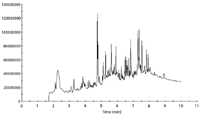
Figure 1: TIC of raw GCâMS data from a urine sample.
The TOF-MS data were processed by the associated deconvolution/data-mining software, which initially applies a background compensation algorithm to the matrix-affected total ion chromatogram (TIC) (Figure 2). This removes interfering ions, flattening the baseline and giving "cleaner" spectra. This allows more reliable identification of compounds down to the lowest concentrations. In addition, the TOF-MS system used is able to produce "classical" electron ionization (EI) spectra for compound peaks. These spectra match those of established or commercial libraries, allowing simple and reliable identification. The creation of new libraries of TOF-MS spectra is not required.
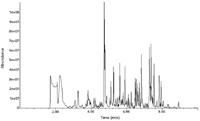
Figure 2: Background-compensated TIC of the urine sample.
To address the problem of compounds coeluted within the TIC, deconvolution of background-free peak spectra is the subsequent step. The speed of data acquisition by the TOF-MS system allows the summation of many single scans to scansets. The scansets provide high S/N values and spectra that are unaffected by the phenomenon of spectral skew, which in turn enables good deconvolution results.
Deconvolution is followed by chemometric data analysis of the distinct spectra. Vectors are created for deconvolved substance spectra as well as for the target compounds. The target and deconvolved vectors are plotted against each other to determine matches. When a target compound is detected, the software derives a match coefficient (0–1). Ultimately, a report is generated listing all positive compound identifications.
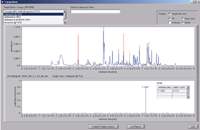
Figure 3: Software interface: Upper window shows the background-compensated TIC of urine sample with target drugs highlighted (red bars). Lower window illustrates the identification of diazepam.
The background-compensated TIC of the urine sample within the deconvolution software can be seen in Figure 3. The software has interrogated the TIC for compounds listed in the drug library created. Detected target compounds are represented by red bars, and the heights of the bars represent their peak sum. A section of the report of targets found can be seen in Table I.

Table I: Section of report listing drugs of abuse found in the urine sample
A number of compounds that would have been difficult or even impossible to identify from quadrupole data or using traditional compound identification software have been identified in the sample. In particular, it has been difficult historically to detect benzodiazepines using GC–MS due to the polarity of the nonderivatized analytes. The high sensitivity and nonskewed classical spectra provided by the TOF-MS system in combination with the advanced deconvolution software used has resulted in the confident identification of this class of compounds, underivatized.
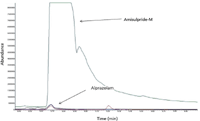
Figure 4: Overlaid chromatograms showing amisulpride and alprazolam coeluted.
To illustrate this, Figure 4 shows a saturated amisulpride peak that is overlapping a small concentration of alprazolam completely. By limiting the mass range between 100 and 400 amu, alprazolam is positively identified, showing good spectral similarity to the library spectrum (Figure 5) and, resultantly, a very high match coefficient (0.88). The deconvolved spectrum is plotted using white for certain and red for uncertain ions, and the library spectrum (green) is shown below. The similarity of both spectra is excellent despite the large matrix interference. Using this novel software, it is also possible to library search unknown peaks in the NIST database for confident and comprehensive profiling of the sample.
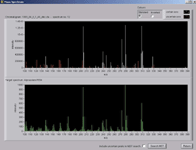
Figure 5: Comparison of sample and library spectra for alprazolam showing strong match.
Conclusion
The overall sample enrichment factor can pose a problem for many analytical detection systems, but the TOF-MS system used in this study was able to record high-quality mass spectra over a wide concentration range. This is particularly important for the analysis of DOA in urine samples as a variety of drug components at very different concentration levels, as well as those coeluted, have to be detected. Even in the presence of a high matrix background, the TOF data, employing the unique deconvolution algorithm, allowed the identification of trace drugs of abuse with a high similarity to commercial libraries. The ability of the instrument to deliver NIST-searchable spectra means that proprietary libraries can be employed without modification.
This very sensitive GC–TOF-MS system configuration, together with the automated evaluation software, can be used for analytical tasks that up until now would have required additional derivatization.
Petra Gerhards, Pierre Schanen, and Gerhard Horner are with ALMSCO International, Llantrisant, UK.
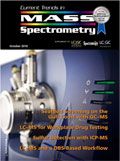
High-Speed Laser MS for Precise, Prep-Free Environmental Particle Tracking
April 21st 2025Scientists at Oak Ridge National Laboratory have demonstrated that a fast, laser-based mass spectrometry method—LA-ICP-TOF-MS—can accurately detect and identify airborne environmental particles, including toxic metal particles like ruthenium, without the need for complex sample preparation. The work offers a breakthrough in rapid, high-resolution analysis of environmental pollutants.
The State of Forensic Science: Previewing an Upcoming AAFS Video Series
March 10th 2025Here, we provide a preview of our upcoming multi-day video series that will focus on recapping the American Academy of Forensic Sciences Conference, as well as documenting the current state of the forensic science industry.
Previewing the American Academy of Forensic Sciences Conference
February 14th 2025This year, the American Academy of Forensic Sciences Conference is taking place from February 17–22, 2025. We highlight the importance of spectroscopy in this field and why we’re covering the conference this year.